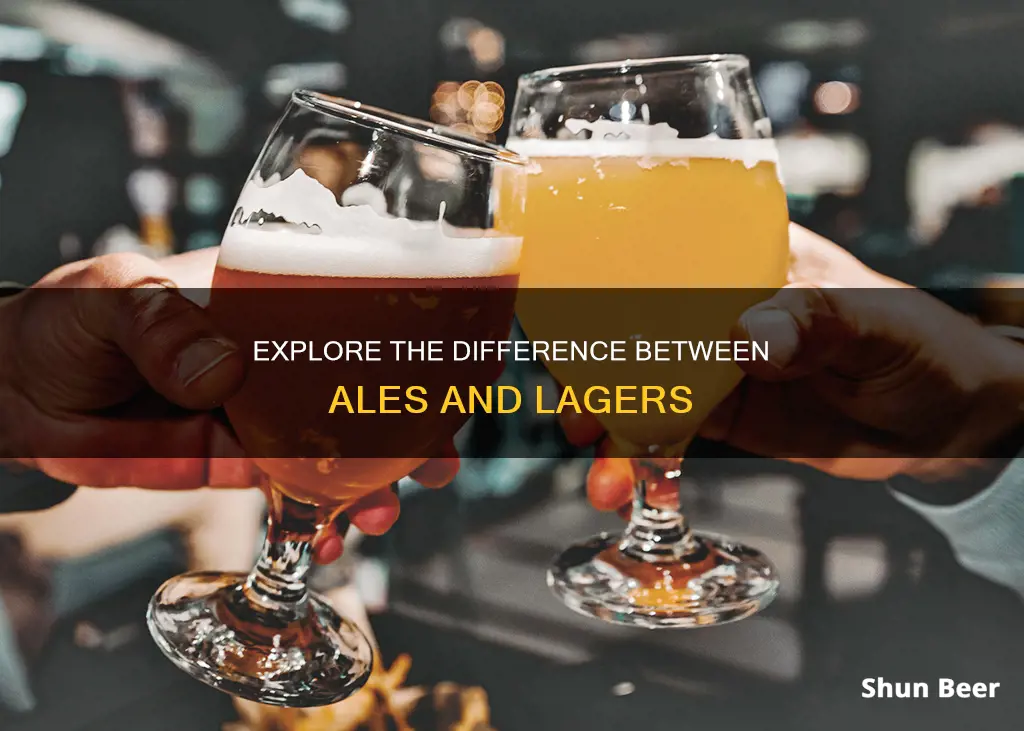
Beer is a beloved alcoholic beverage that has been enjoyed for centuries. But what is the difference between ale and lager? The answer lies in the fermentation process and the type of yeast used. All beer falls into one of two categories: ale or lager. Ales are fermented with top-fermenting yeast at warmer temperatures, resulting in a fruitier and more complex flavour. Lagers, on the other hand, are fermented with bottom-fermenting yeast at cooler temperatures, producing a smoother and crisper taste with less fruity notes.
What You'll Learn

Fermentation technique
The primary distinction between ales and lagers is the fermentation technique, specifically the type of yeast and temperature used.
Ales are fermented with Saccharomyces cerevisiae, or ale yeast, which is the largest and oldest yeast variety in the brewing world. This yeast is commonly referred to as "top-fermenting" because the most obvious fermentation activity occurs on the surface of the beer, though ale yeast also tends to flocculate at the surface before eventually precipitating out completely to the bottom of the fermenter. Ale yeast typically ferments at warmer temperatures, between 60–78°F (16–26°C), with some strains requiring temperatures as high as 95–100°F (35–38°C). The warmer temperatures result in a more vigorous fermentation process, and ales can generally ferment and age in a shorter time frame (2-5 weeks).
Lagers, on the other hand, are fermented with Saccharomyces pastorianus, a hybrid of ale yeast (S. cerevisiae) and a more cold-resistant yeast called Saccharomyces bayanus. This yeast is referred to as "bottom-fermenting" due to its lack of apparent activity on the surface of the fermenting lager. Lager yeast thrives at lower temperatures, generally between 41–50°F (5–10°C), though some strains can ferment at temperatures up to 65°F (18°C). The fermentation process for lagers is slower and calmer, and because lager yeasts can ferment more kinds of sugars, the final beer often has a crisper palate. The cooler fermentation temperatures also mean that yeast-derived flavours are less prevalent in lagers. Lagers typically take longer to ferment, usually 4-8 weeks, and also have an additional lagering step where the beer is aged for at least 2-3 weeks near 32°F (0°C). This cold aging period allows lager yeasts and other proteins to precipitate out, resulting in the signature smooth, crisp drinking experience of lagers.
Stout vs Porter: Unveiling Beer's Dark Secrets
You may want to see also

Yeast used
The main difference between ales and lagers is the type of yeast used in the brewing process. Ales are fermented with top-fermenting yeast at warm temperatures (60˚–70˚F), while lagers are fermented with bottom-fermenting yeast at cold temperatures (35˚–50˚F).
The strain of yeast typically used for ale fermentation is called ale yeast or Saccharomyces cerevisiae. This yeast ferments the sugar into alcohol at the top of the fermentation tank near the surface of the wort. This allows the brewer to skim the yeast from the wort and reuse it in other batches. Top-fermenting yeasts work vigorously in warm temperatures, so the fermentation time for ales can be relatively short, usually two to five weeks.
Lagers, on the other hand, are fermented with bottom-fermenting yeast, specifically Saccharomyces pastorianus (formerly known as Saccharomyces uvarum). Bottom-fermenting yeasts sink to the bottom of a fermentation tank when they have consumed all the sugars to form alcohol. Because of the cooler temperatures and the action of the yeast, lagers take longer to ferment, typically four to eight weeks.
The choice of yeast and fermentation technique has a significant impact on the resulting beer style. Ales tend to be sweeter and fuller-bodied, while lagers are smoother with crisp notes from the cold, slow fermentation.
Explore the Difference Between Ales and Lagers in Beer
You may want to see also

Temperature
Ales are typically fermented at warmer temperatures, ranging from 60°F to 78°F (16°C to 26°C). Some sources specify a narrower range of 60°F to 75°F, while others state a range of 60°F to 70°F. This warmer temperature range encourages the activity of ale yeast, which ferments at the top of the tank, creating a vigorous and relatively quick fermentation process. The warmer temperatures also contribute to the development of fruity aromas and flavours in ales, including notes of pear, apple, and rose.
On the other hand, lagers are fermented at cooler temperatures, generally between 41°F and 50°F (5°C to 10°C). Some sources specify a narrower range of 42°F to 55°F or 45°F to 55°F, while others state a range of 48°F to 58°F. This cooler temperature range suits the lager yeast, which ferments at the bottom of the tank. The slower and calmer fermentation process of lagers results in a cleaner, crisper flavour profile with fewer by-products, such as esters, that are more commonly found in ales.
The difference in fermentation temperatures between ales and lagers has a significant impact on the overall character and flavour of the beer. Ales tend to have a stronger, more complex flavour with a wider spectrum of flavours, while lagers offer a cleaner, crisper, and more refreshing drinking experience.
Additionally, the fermentation temperature influences the fermentation duration. Ales, with their warmer temperatures, typically have a shorter fermentation time, usually lasting two to five weeks. In contrast, lagers, with their cooler temperatures, require a longer fermentation period, typically ranging from four to eight weeks.
Beer vs Lager: What's the Difference?
You may want to see also

Flavour
The flavour of beer is determined by the type of yeast used and the temperature at which it is fermented. The difference between lager and ale yeast—and the way these strains affect fermentation—has a significant impact on the flavour and character of a beer.
Lager is known for its smooth, crisp flavour profile. It tends to be lighter in colour than ale beer, although there are exceptions. The lagering process, which involves storing the beer at a cold temperature for several weeks, allows the flavours to settle out after fermentation, resulting in a clean and refreshing taste. The longer lagering process also means that lager yeast ferments at a lower temperature, which produces a beer with a less complex flavour profile than ale.
Ale, on the other hand, has a stronger, more complex flavour profile. It tends to be less sweet, more bitter, and darker in colour compared to lager. Ale yeast ferments at warmer temperatures, which speeds up the fermentation process. During this warmer, faster fermentation period, the yeast produces a wider spectrum of flavours. This is why you may be able to taste notes of fruit, caramel or spice in a well-crafted ale. These yeast flavours, known as esters, are quite distinct from the fruity or citrusy characters in modern craft ales, which are imparted by hops.
While the type of yeast and fermentation temperature are the main factors that differentiate the flavour profiles of lager and ale, other ingredients added during the brewing process can also contribute to the final flavour. For example, lager's cold treatment process allows the finer flavours of the hops to come out, providing a more delicate flavour. Ales, on the other hand, tend to have a higher hop content, which can result in more bitterness.
Pilsner vs Lager Beer: What's the Difference?
You may want to see also

Colour
Lager beers are often lighter in colour than ales, although there are exceptions. Lager is typically brewed with pale malt, which lends a light colour to the beer. Beer styles such as pilsners, lagers, and wheat beers are often light in colour, ranging from pale yellow to light gold. Some darker lager styles, such as porters and stouts, are nearly black in colour.
Ales, on the other hand, can vary in colour from light to dark but tend to be darker than most lagers. Pale ales and IPAs can be similar in colour to some lighter lagers, ranging from light amber to golden. Brown ales and amber ales are often darker, ranging from reddish-brown to dark brown. Belgian ales can be even darker, with some styles approaching black.
The colour difference between lager and ale is due to the types of malt used in each style. Lager is often brewed with pale malt, which is lightly roasted and produces a light colour. Ales, on the other hand, are often brewed with darker malts, such as caramel or chocolate malt, resulting in a darker colour. Additionally, the amount of malt used in the brewing process can affect the final colour, with more malt leading to a darker beer.
Frequently asked questions
The main difference between ale and lager is the type of yeast used and the temperature at which they are fermented. Ales are fermented with top-fermenting yeast at warm temperatures (60˚–75˚F), while lagers are fermented with bottom-fermenting yeast at cold temperatures (41˚–55˚F).
Ales tend to have a stronger, more complex, and fruitier flavour than lagers. Lagers have a cleaner, crisper, and smoother taste, allowing the malt and hops to be more noticeable.
Some popular types of ale include brown ale, pale ale, Indian pale ale (IPA), stout, and Belgian ale.
Some popular types of lager include pilsners, bocks, Vienna lagers, and Märzen (also known as Oktoberfest).







